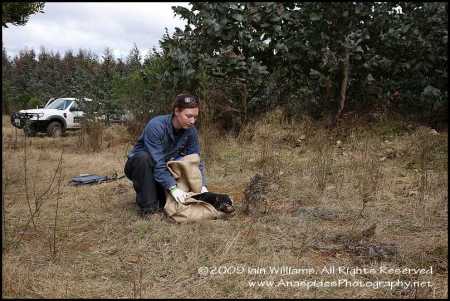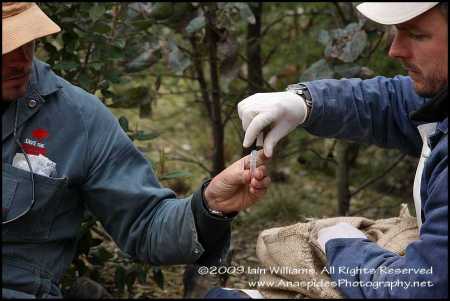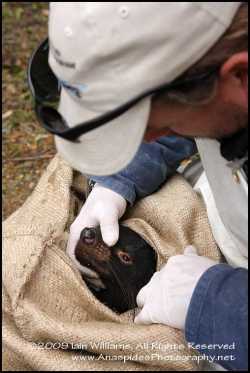 I’ve just spent the last week or so photographically documenting the activities of the Tasmania Government Devil Task Force (DTF) while they have been working on what they call a “Rolling Disease Suppression Line”. This has been in association with The Devi Task Force belonging to Tasmania State Government. It's intended in due course to produce several articles on the team and the devil to raise awareness of the devil's plight in Tasmania.
I’ve just spent the last week or so photographically documenting the activities of the Tasmania Government Devil Task Force (DTF) while they have been working on what they call a “Rolling Disease Suppression Line”. This has been in association with The Devi Task Force belonging to Tasmania State Government. It's intended in due course to produce several articles on the team and the devil to raise awareness of the devil's plight in Tasmania.
Devil Task Force Team
The field component of the DTF comprises 3 groups of 3 individuals and each group is  allocated different areas to work within the state of Tasmania. Each group consists of a Field Zoologist, Field Officer, and a volunteer. Supplemental to this is a separate team comprising two veterinarians.
allocated different areas to work within the state of Tasmania. Each group consists of a Field Zoologist, Field Officer, and a volunteer. Supplemental to this is a separate team comprising two veterinarians.
Through field monitoring (capture & release) the DTF strives to determine the extent and prevalence of Facial Tumour Disease (FTD) within populations of Tasmanian Devils (Sarcophilus harrisii). Broadly speaking, FTD is more prevalent in eastern populations than western populations and determining which devil populations are affected can assist in the management and quarantine of the disease.
Most of the week involved an early wake up and rendezvous with one of the DTF teams to shadow their activities whilst they checked, cleaned and reset devil traps. Devils captured in traps the evening before (Tasmania Devils are nocturnal) were removed from the trap, weighed and inspected for the FTD before being released. If FTD was suspected or observed a call was made to the roving veterinarian unit who attended the animal to obtain further information for analysis which included a biopsy and blood taking. Each captured devil then had a digital ID chip inserted beneath its skin between the shoulder blades. The chip can be read by a supermarket style scanner gun.
Additional to this process was the collection of information on each captured devil which included sex, sexual maturity, carried young, age and any obvious deformities. The information collected is then collated at a later date and added to a database to assist in the management of disease free devil populations.
 DTF personnel work a busy day starting at dawn and only ending after sunset. Up to 20 traps are set along a pre-allocated line within the forest, forest coup or farmland. Much of the work is off the main road and along forest trails and four wheel drive tracks involving the use of four wheel drive vehicles.
DTF personnel work a busy day starting at dawn and only ending after sunset. Up to 20 traps are set along a pre-allocated line within the forest, forest coup or farmland. Much of the work is off the main road and along forest trails and four wheel drive tracks involving the use of four wheel drive vehicles.
Just because you set a trap doesn’t mean you will capture a devil; often traps were left unsprung and at other times they were sprung by other animals such as the Tasmania Tiger Quoll (Dasyurus maculates). In the 5 days I worked with DTF we drove 1700 kilometres (1056 miles) in rain, hail, sleet and sunshine!
Thanks is due to the Devil Task Force Team (Phil, Holly & Anton), Veternarians (Michelle & Kim) and staff administration (Caroline & Kim) for allowing access.
Images top to bottom: Devil Task Force Zoologist Holly Devereaux (Field Officer) releases captured devil, Anton (Volunteer) & Phil (Team Leader) take biopsy for tumour desease, Phil (Zoologist) inspects devil to determine age from teeth.
For further information on the facial tumour disease and the Devil Task Force please go to http://tassiedevil.com.au/
To see a short video of the Tasmania devil taken in the wild, click here to view on U-Tube.